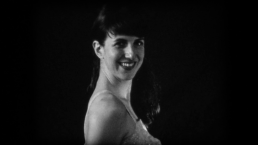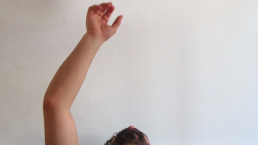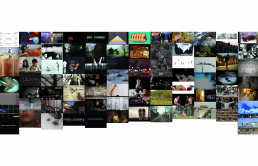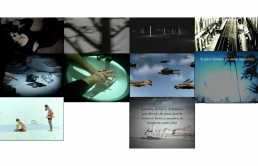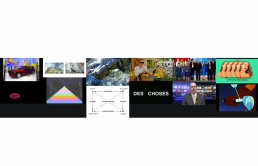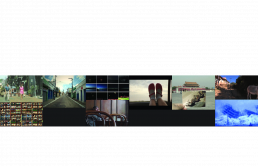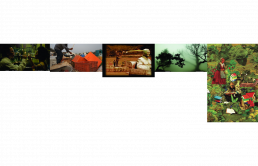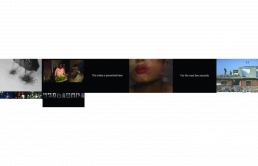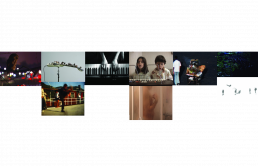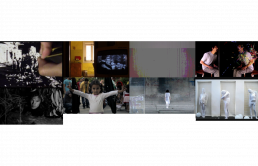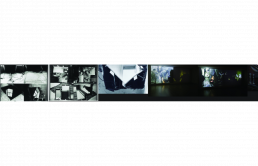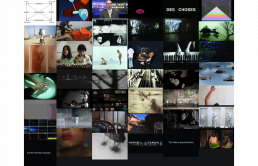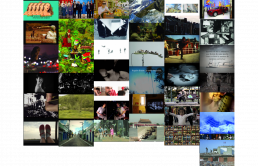“FUSO 2012 – 21 Agosto a 7 Setembro”
Programação
22 Agosto, 22h
Museu da Eletricidade
Secção Competitiva Portugal
Seleção por Jacinto Lageira
Pintura de história e arte de história: novas figuras
Conflitos, guerras, atentados, revoluções, torturas, catástrofes, todas estas violências extremas recentes, legítimas ou não, tornaram-se temas artísticos fictícios, semifictícios ou semidocumentários que redefiniram a antiga figura do «pintor de história».
Pensando, por exemplo, em artistas como Jeff Wall, Harun Farocki ou Eric Fischl (Tumbling Woman, que causou grande escândalo e censura), ou repórteres de guerra que se proclamam artistas, como Luc Delahaye, temos que repensar o que é ser hoje artista de história. Uma programação de vídeos e de curtas (ou longas) metragens, e até pequenos filmes realizados com telemóveis, poderiam ser apresentados e contribuir assim para uma reflexão sobre as noções de representação, de ficção, de documento ou de documentário que está no centro da criação contemporânea.
Jacinto Lageira
António MV, Go Political, 2011, 1’19’’
O cruzamento do mundo do espetáculo e a resistência política como matéria de consumo, alienação ou sugestão?
Filme António MV
Com Mariana Tengner Barros
Música João Ferro Martins
Pedro Matias, untitled, 2012, 0’26’’
O objeto é normalmente o que é manipulado e controlado. O conceito de submissão a um objeto foi o mote para o início desta série de trabalhos, sendo que palavras como fetichismo e objetofilia enquadram bem esta pesquisa. Onde fica a linha de divisão entre a normalidade e o divergir desse ‘normal’? Como podemos ver as atividades sexuais de alguém como parte do que eles são enquanto pessoas?
O objeto irreconhecível tornou-se personagem principal, enquanto que o homem, submisso ao seu desejo.
Imagem e Edição Pedro Matias
Conceito Pedro Matias
Agradecimentos Ângelo Custódio
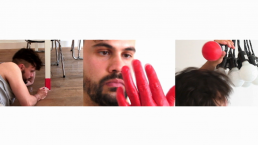
Pedro Matias, untitled, 2012, 4’
Como podemos reorganizar e redefinir as partes de um objeto? Uma cadeira será sempre uma cadeira para todos nós? É a minha mão somente uma parte do meu corpo ou poderá ser algo mais?
Posso eu ter sentimentos pela minha mão? Posso amar a perna de alguém?
O questionar da atração e relação entre um objeto e um homem é levada a um outro nível neste trabalho, onde foi necessário o repensar do diálogo entre objeto e corpo.
A boca é a via de comunicação, onde tudo começa e acaba. A ação ultrapassa o sexual, começando um novo alfabeto de ‘estranheza’ e de sentimentos ‘inquietantes’.
A ação repete-se uma e outra vez como um jogo de necessidade e obrigação.
O sublinhar a vermelho, redefine e redesenha a arquitetura do objeto, separando-o do resto do seu corpo. Já não são uma lâmpada, uma mesa ou uma mão, mas passam a ser objetos obrigatórios a engolir e destruir. É a construção e destruição de um objeto em simultâneo.
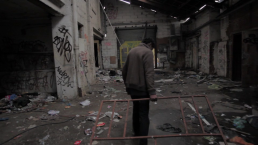
Bruno Ramos, Factory, 2011, 10’17’’
Prémio Aquisição FUSO/Fundação EDP
No centro de Londres, P. Sylva leva uma vida incomum. É um fantasma numa das mais movimentadas cidades do mundo e defende o seu modo de vida. Factory explora a relação entre a pessoa e o espaço que ela habita, através de um conjunto de movimentos pré-determinados. O filme foi criado com base numa narrativa audiovisual pré-definida e centrada na vida quotidiana do personagem.
Com P. Sylva, H. Hassan
Realização Bruno Ramos
Desenho de som Sérgio Cruz
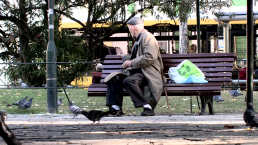
Bruno Canas, Lisboa#1, 2009, 1’
A missão de “Lisboa” é comunicar a estranheza que existe em cada humano para, através de uma reflexão sobre nós e os outros, nos tornarmos mais próximos.
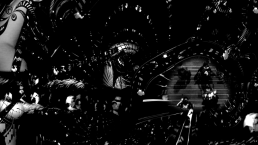
Bruno Canas, Existência abstrata e obediência, 2011, 2’37’’
A existência da obediência numa vida em rede aparentemente livre.
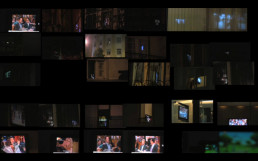
Filipe Afonso, Televisão, 2012, 15’
Eu ando, no meio da noite, na cidade e ouço televisores. Suponho que todos juntos poderiam contar uma história e me darem um sinal antes de chegar a casa. É como uma extensão de dentro da casa e dos seus moradores para o exterior, para a rua e para mim. Eu ando. Como um fantasma. Entrando em todas essas casas… Enquanto ando, aproximo-me, tento ouvir melhor, ver mais, mais, mais…
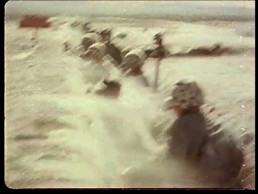
Rita Figueiredo, Clap your Hands, 2012, 6’07’’
Votação do público
Clap your Hands é um filme realizado totalmente a partir de imagens e sons de arquivo provenientes do Prelinger Archives.
Partindo da ideia de que a inovação tecnológica da imagem em movimento foi imprescindível ao avanço da ciência, neste caso à bomba atómica, o filme mostra o momento de preparação que antecede a explosão, até culminar com pormenores da mesma, vista a partir de diferentes objetivas.
A sua narrativa divide-se claramente em duas partes que de certa forma se repetem e se complementam, sempre em crescendo, invocando imagens tecnológicas de diferentes origens, readaptadas e manipuladas aqui para criarem outros sentidos.
A banda sonora é o contraposto desta manipulação imagética – sem qualquer utilização de artifício, é toda construída a partir de sons do corpo humano – o som de palmas, do sopro e da voz humana. O sopro e a voz, relacionam-se com o movimento do ar criado pela explosão e pelo movimento dos “objetos”. O som de palmas que gradualmente se constrói em ritmo, transforma-se em palavra, e Clap your hands, música coral que glorifica Deus Criador, tem a acompanhar por imagem o expoente máximo de destruição.
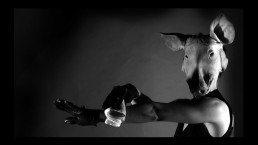
Renata Ferraz, EU, European Union, 2012, 4’25’’
Dizem-nos a todo o tempo e em todos os lugares que a multiplicidade de possibilidades de modos de ser e de modos de viver ofertados na contemporaneidade expressariam o caráter tolerante da sociedade em que vivemos. Sem querer negar as conquistas e os benefícios da proliferação das possibilidades de conduta de que usufruímos no mundo de hoje, EU, European Union lança a seguinte interrogação: e se o conceito de tolerância não fosse apenas um bem inconteste, mas igualmente um modo bastante astuto de controlar o potencial contestador da alteridade?
Reconhecer o outro como outro, em muitos casos, é apenas uma forma de controlo, já que esse outro tolerado costuma ser aceite apenas com a condição de não pôr em causa o próprio ponto de vista daqueles que levantam a bandeira da igualdade. As diferenças que de facto introduzem abalos na ordem das coisas, por regra, são guilhotinadas.
Realização, Fotografia, Edição, Argumento e Som Renata Ferraz
Música Mário Bakuna
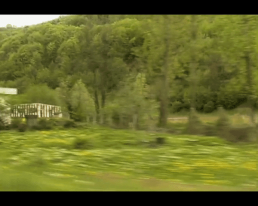
Mara Castilho, Bosnia Road to Srebrenica or the Sound of death, 2012, 11’21’’
Castilho reflete sobre a temática da Ausência, da Solidão e da Intolerância que aqui tomam forma no conflito de raiz religiosa ainda presente na Bósnia e Herzegovina pós-guerra. Como memórias intrusivas, perdidas, ausentes ou algo que não pode ser esquecido ou apagado da memória, Castilho expõe questões universais inerentes ao ser humano.
A matéria prima deste trabalho continua a ser a alma humana e o que a vivência pessoal tem de universal. Aqui há marcas pessoais de um casamento partido pela religião. Castilho viaja vezes sem conta pela Bósnia e Herzegovina numa procura obsessiva por respostas. A perplexidade é dor cravado no peito. O vazio e o abandono, tem aqui corpo de mulher. Castilho dá o seu próprio corpo a todas as mulheres católicas, ortodoxas e muçulmanas violadas e assassinadas nestes e outros espaços bombardeados quando abrigavam velhos e crianças. Filmado por Mara Castilho em várias viagens pela Bósnia & Herzegovina pós-guerra durante 2003 e 2005. Faz parte de uma série de vídeo-instalações e fotografias.
Realização, Imagem e Edição Mara Castilho
Filmado na Bósnia & Herzegovina 2003 – 2005 (Goradze, Srebrenica, Sarajevo, Zvornic, Mostar, Tuzla)
Agradecimentos Dalibor Nicolic, Mario Sunjic, Ivana, Alija Kamber, Amila Ramovic, Assim Residovic, Kostas Tzimoulis
Produção Mo.tiv productions
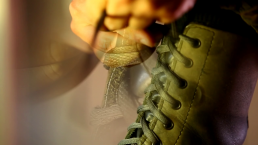
José Chaves, Contagem decrescente, 2012, 5’36’’
Um oficial das forças especiais portuguesas vai partir para mais uma missão no exterior, em local não divulgado. Espera com este testemunho libertar todas as frustrações e desinformação que correm nos media, nos seus pares, na sua família e na sua própria mente. É um testemunho em contagem decrescente, que irá acontecer no final dessa contagem?
Realização José Chaves
Soldado X José Chaves

José Nuno Lamas & Valter Ventura, Uma Tonelada, 2011, 1’
Baseado no mito de Sísifo, José Nuno Lamas e Valter Ventura transportam um peso até que a soma das suas viagens seja uma tonelada. Há uma reflexão sobre a efemeridade das ações humanas, a passagem do tempo e o desvanecimento do esforço vão.
“FUSO 2012 – August 21 to September 7”
Programação
August 22, 10pm
Museu da Eletricidade
Open Call
Selection by Jacinto Lageira
Painting of history and art of history: new figures
Conflicts, wars, attacks, revolutions, tortures, catastrophes, all this extreme recent violence, whether legitimate or not, became unreal, almost unreal or semi-documentary artistic themes that redefined the ancient figure of the “painter of history.”
For example, thinking of artists like Jeff Wall, Harun Farocki or Eric Fischl (Tumbling Woman, who caused great scandal and censorship), or war reporters who proclaim themselves artists, like Luc Delahaye, have to rethink what it is to be an artist of history nowadays. A program consisting of videos and short films, even small films made with mobile phones, could be presented and thus contribute to a reflection on the notions of representation, fiction, document or documentary that is at the center of creation in contemporary art.
Jacinto Lageira
António MV, Go Political, 2011, 1’19’’
The intersection between the world of entertainment and political resistance as a matter of consumption, alienation or suggestion?
Film António MV
With Mariana Tengner Barros
Soundtrack João Ferro Martins
Pedro Matias, untitled, 2012, 0’26’’
The object is usually what is manipulated and controlled. The concept of submission to an object was the motto for the beginning of this series of works, and words such as fetishism and objectophilia fit this research. Where is the border line between normality and divergence from this normality? How can we see someone’s sexual activities as part of who they are as people?
The unrecognizable object became the main character, while man is submissive to his desire.
Concept, Image and Editing Pedro Matias
Acknowledgements Ângelo Custódio

Pedro Matias, untitled, 2012, 4’
How can we reorganize and redefine parts of an object? Will a chair always be a chair for us all? Is my hand only a part of my body or could it be something else?
Can I have feelings for my hand? Can I love someone’s leg?
In this work, the questioning of the attraction and relationship between an object and man is taken to another level, where it was necessary to rethink the dialogue between object and body.
The mouth is the way of communication, where everything begins and ends. The action goes beyond the sexual, starting a new alphabet of ‘strangeness’ and ‘disturbing’ feelings.
Action repeats over and over again as a game of necessity and obligation.
Underlining in red, it redefines and redraws the object’s architecture, separating it from the rest of his body. They are no longer a lamp, a table or a hand, but they become obligatory objects to be swallowed and destroyed. It is simultaneously the construction and destruction of an object.

Bruno Ramos, Factory, 2011, 10’17’’
FUSO/EDP Foundation acquisition prize
In central London, P. Sylva leads an unusual life. He is a ghost in one of the busiest cities in the world and defends his way of living. Factory explores the relationship between the person and the space he inhabits, through a set of predetermined movements. The film was created based on a pre-defined audiovisual narrative and focused on the character’s daily life.
With P. Sylva, H. Hassan
Directing Bruno Ramos
Lighting design Sérgio Cruz

Bruno Canas, Lisboa#1, 2009, 1’
The mission of this video is to communicate the strangeness which is present in each human to become closer to each other, through the reflection on ourselves and others.

Bruno Canas, Existência abstrata e obediência, 2011, 2’37’’
The existence of obedience in a seemingly free network living.

Filipe Afonso, Televisão, 2012, 15’
In the middle of the night, I walk by the city and I can hear televisions. I suppose that all together could tell a story and give me a sign before I get home. It’s like an extension from inside the house and its residents to the outdoors, to the streets and to myself. I walk. Like a ghost. Entering all these houses… I get closer as I walk, trying to listen carefully, to see more, and more, and more…

Rita Figueiredo, Clap your Hands, 2012, 6’07’’
Public Prize
Clap your Hands is a film made entirely from images and archive sounds from the Prelinger Archives.
Starting from the idea that technological innovation of the moving image was essential to the advance of science, in this case to the atomic bomb, the film shows the moment of preparation that precedes the explosion, showing its details, seen from different perspectives.
Its narrative is clearly divided in two parts, which are repeated and complement each other in a way, always growing, invoking technological images from different origins, readapted and manipulated here to create other meanings.
The soundtrack is the counterpart of this imagery manipulation – without any artifices, it is all constructed from sounds produced by the human body – from clapping hands, breath and voice itself. Breath and voice are related to the movement of the air created by the explosion and to the movement of the “objects”. The sound of clapping hands gradually builds itself up into rhythm and also becomes the word, and Clap your hands, choral music which glorifies God the Creator, is supported by images of the ultimate exponent of destruction.

Renata Ferraz, EU, European Union, 2012, 4’25’’
We are told at all times and in all places that the multiplicity of possibilities on ways of being and living offered in these contemporary times would express the tolerant character of the society in which we live. Without denying the achievements and benefits of the proliferation of possibilities of conduct we enjoy nowadays, EU, European Union raises the following question: what if the tolerance concept was not only an unquestionable good, but also a very astute one to control the adverse potential of alterity?
In many cases, to recognize the other as equal is only a way to control, since this other tolerated person is usually accepted only on the condition that it does not call into question the very point of view of those who raise the banner of equality. The differences that in fact affect the order of things are usually guillotined.
Directing, Image, Editing, Script and Sound Renata Ferraz
Soundtrack Mário Bakuna

Mara Castilho, Bosnia Road to Srebrenica or the Sound of death, 2012, 11’21’’
Castilho reflects on the theme of Absence, Solitude and Intolerance, which takes shape here by the religious conflict still present in post-war Bosnia and Herzegovina. By intrusive memories, lost, absent ones, or something that cannot be forgotten or erased from memory, Castilho exposes universal issues inherent to the human being.
The element of this work continues to be the human soul and the universality on personal experience. Here are personal marks of a marriage broken by religion. Castilho travels over and over again by Bosnia and Herzegovina in an obsessive search for answers. Perplexity is pain nailed to the chest. Emptiness and abandonment take a woman’s body here. Castilho gives her own body to all the Catholic, Orthodox and Muslim women raped and murdered in these and other bombed places when they sheltered old men and children. Shot by Mara Castilho on several journeys to post-war Bosnia and Herzegovina during 2003 and 2005. It’s part of a series of video-installations and photographs.
Directing, Image and Editing Mara Castilho
Shot in Bósnia & Herzegovina 2003 – 2005 (Goradze, Srebrenica, Sarajevo, Zvornic, Mostar, Tuzla)
Acknowledgements Dalibor Nicolic, Mario Sunjic, Ivana, Alija Kamber, Amila Ramovic, Assim Residovic, Kostas Tzimoulis
Production Mo.tiv productions

José Chaves, Contagem decrescente, 2012, 5’36’’
An official of the Portuguese Special Forces will leave for another mission abroad, in an undisclosed location. With this testimony, it hopes to release all the frustrations and misinformation that run in the media, in their peers, in their family and in their own mind. Is it a countdown, what will happen at the end of it?
Directing José Chaves
X Soldier José Chaves

José Nuno Lamas & Valter Ventura, Uma Tonelada, 2011, 1’
Based on the myth of Sisyphus, José Nuno Lamas and Valter Ventura carry a weight until the sum of their trips completes a ton. There is a reflection on the ephemerality of human actions, the passage of time and the fading of vain effort.
